Easter Sunday is not the only time you can get to see colorful eggs. There are chickens out there who lay colored eggs the natural way. One of the most fascinating ones among them is the chickens that lay pink eggs.
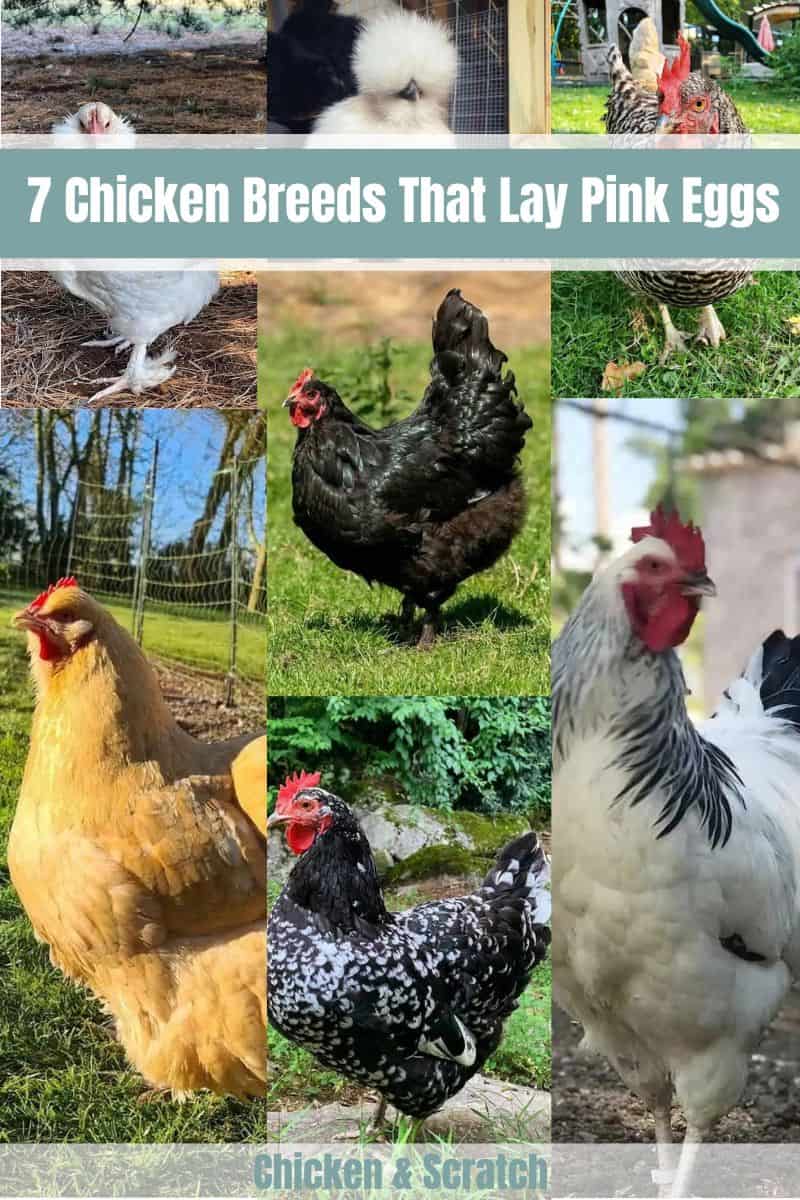
How Do Chickens Lay Pink Eggs?
When hens reach the age of 5 to 6 months, they generally start laying eggs. And they will continue to do so until they become very mature. When they reach an age of about 5-10 years, depending on the breed, hens typically start to significantly reduce egg production.
Whenever people think of eggs, not many know the existence of colored ones. We mostly think of white ones that we see at supermarkets or in groceries. So how do some chickens lay pink eggs exactly?
The Process of Eggs Turning Pink
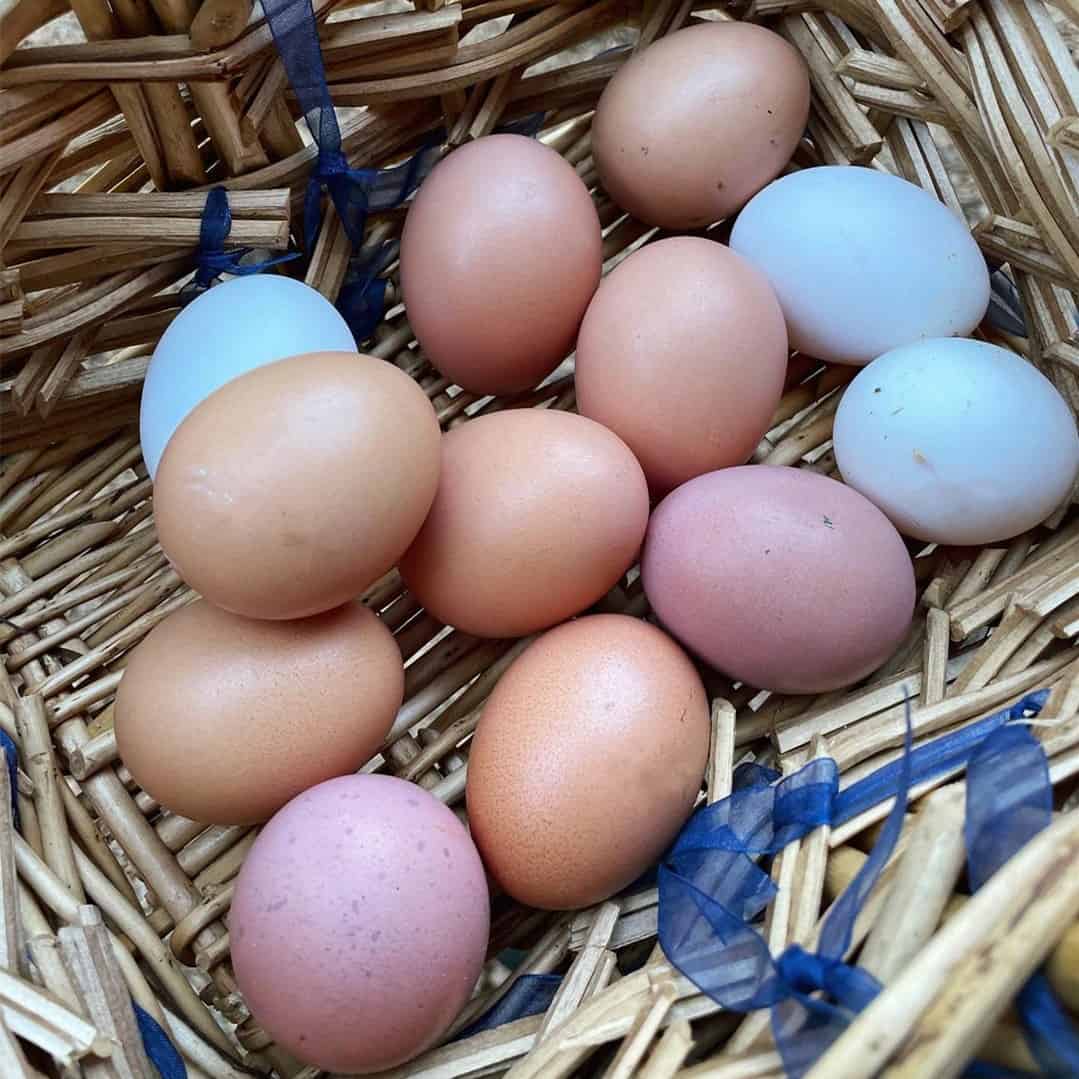
When a chicken produces an egg, it takes over a day for that to happen. A significant portion of the egg formation process is dedicated to shell formation.
At the start of the process, the egg’s color is white. However, pigments are secreted from the uterus of the hen. The pigment, referred to as protoporphyrins, is the one responsible for the brown color of some eggshells. The pinkish hue seen in some eggs is usually due to the bloom or cuticle, a protective layer that coats the eggshell. The pigment that tints pink eggs leaves a pale brown or cream-pink color.
7 Chicken Breeds That Lay Pink Eggs
Now that you have figured out how chickens can lay pink eggs, it’s time to look into the different breeds that produce these kinds of eggs. There are a couple of them, so sit back and relax and discover the seven chickens that can give you those pink eggs!
1. Salmon Faverolles

- Lifespan: 5 – 7 years
- Weight: 6.5 – 8 lbs
- Egg Production: Good
- Egg Size: Medium
This chicken breed hails from France. Its name comes from a village found in Aisne. If you take a look at its genetic makeup, the following breeds make up the Faverolles:
The poultry farmers in France wanted a dual-purpose bird. And this is what they got with the Faverolles. This breed was able to produce a good amount of both meat and eggs. One of the varieties that became popular, especially in the United States, was the Salmon Faverolles. This kind got its name from the pinkish tinge that you can find on its body.
The male Salmon Faverolles usually weigh about 8 lbs. The female ones, on the other hand, have an average weight of about 6.5 lbs. The appearances between the rooster and hen of this breed are pretty different.
The hens have a five-point red single comb. Most of them have small wattles. Some hens do not have wattles at all. The hens’ bodies are broad, making their breast and back parts look wide. Their feet have five toes and some feathers.
Their feathers usually fall between light honey to light brown. It gives them that salmon coloring that they have. The Salmon Faverolles roosters do not have the salmon brown color that most hens have. They have feathers on their belly, beard, and tail.
Salmon Faverolles can live between 5 to 7 years. They can lay eggs 3 to 4 times a week. If you have a couple of Salmon Faverolles in your poultry or flock, expect to see those pink eggs that they are known for.
Apart from being great providers of meat and eggs, Salmon Faverolles are also great to be around. They are friendly, docile, and cute. They also have great personalities, and they don’t mind being around people.
2. Croad Langshan

- Lifespan: 8 – 10 years
- Weight: 7.5 – 9.5 lbs
- Egg Production: Normal
- Egg Size: Large
The Croad Langshan is perhaps one of the most ancient breeds around. And like another breed that we’ll cover later in our list, you can trace the origin of this particular breed to China. In the Chinese language, Langshan meant “Wolf Hill. It’s a picturesque location in the Eastern region of the People’s Republic.
The Croad Langshan was such an exquisite chicken breed that it was eventually introduced to poultry enthusiasts beyond China. In the 19th century, the secret was out, first through Major F. T. Croad, hence the name Croad Langshan.
From China, Major Major F. T. Croad brought the Langshan chickens to England in the 1870s. By the end of the 1870s, the Croad Langshan had been introduced to the United States. The Americans loved it, and the rest, as some would say, is history.

One of the most defining features that make the Croad Langshan unique is its height. This bird falls in the tall and big category. Their legs are quite long, papered with some feathering here and there. They have high tail feathers, sometimes nearly as tall as their head. They usually come in either black, white, or blue colors.
The male Croad Langshan is around 9.5 lbs, while its female counterpart is around 7.5 lbs. There are also bantam varieties of this breed, with roosters weighing around 36 oz and hens around 32 oz.
The Croad Langshan is a dual-purpose breed. It can give you high-quality white meat and a mountain of eggs. The hens produce about 180-200 eggs per year. And as with most hens, their egg production declines after a couple of years. When you see some of the eggs the hens produce, you will probably be delighted. They produce brown eggs that have tints of pink and other colors.
3. Barred Rock
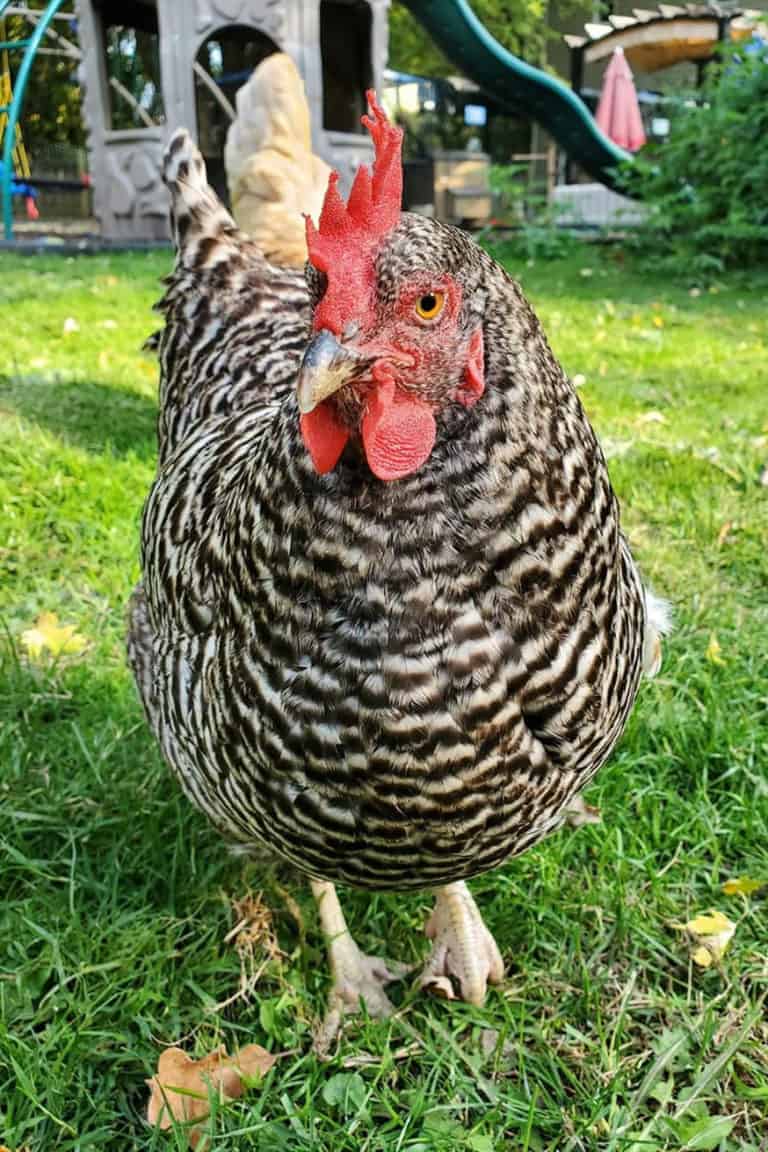
- Lifespan: 6 – 8 years
- Weight: 6 – 7 lbs
- Egg Production: Good
- Egg Size: Large
If you are looking for a chicken breed that works hard and lays pink eggs, then look no further! You need to get yourself a Barred Rock chicken.
One of the famous chickens to grace backyards and flocks, the Barred Rock is a very productive variety. They can give you both meat and eggs!
If you are tracking down the origins of the Barred Rock, you would know that it’s a product of various Plymouth Rock Chicken varieties. People were aware of the existence of the Barred Rock around the 1800s, making it one of the oldest known breeds in the United States.
Due to some circumstances, it somehow disappeared from the limelight. However, before 1870 ended, the re-emergence of the Barred Rock chicken happened in Massachusetts.
There are a lot of noticeable differences between a Barred Rock rooster and a hen. The male Barred Rock has a prominent and large comb, and its hind features long, short, and curvy feathers. The female one, on the other hand, has a less noticeable comb.
And its barred feathers have wider white bars. Apart from the distinctive physical attributes, the Barred Rock roosters also crow, especially at the crack of dawn. While crowing usually happens when they reach their sexual maturity, sometimes it happens earlier than that.
As the Barred Rock chickens are known as a high-yielding breed, the hens can produce about 5-6 eggs a week. On average, they can lay about 200-220 eggs annually. Apart from the quantity, the eggs that come from the hens have brown and pink colors. In the first three years, expect an abundance of eggs, but this would wane as soon as the hen ages.
4. Light Sussex

- Lifespan: 5 – 7 years
- Weight: 8 – 10 lbs
- Egg Production: Excellent
- Egg Size: Large
If you are wondering what other ancient chicken breeds are out there, do not rule out the Light Sussex. This breed has been around since the Roman invasion of what is now England. It has gone through some sort of evolution – from being a table bird to a dual-purpose breed. They are, perhaps, one of the most productive chicken breeds that you can find out there.
The bodies of Light Sussex chickens are white. You can see hints of black on their tail and wingtips. There are also black feathers around their neck, giving them an attractive appearance. The male Light Sussex weighs around 9 lbs. The female one is about 7 lbs. The Light Sussex also has bantam varieties, with the rooster weighing around 3.3 lbs and the hens are about 2.4 lbs.
If you are in the process of setting up a coop or flock, the Light Sussex chickens are perfect for beginners. They are friendly and calm. They are comfortable in both open and confined spaces. If you let them out in the open, they are good foragers.
A Light Sussex hen can give you an average of 250-275 eggs per year. There are some hens who can actually give you more than that! The Light Sussex hens have large eggs. These eggs are either cream, light brown, or pink. Imagine getting over 200 pink-colored eggs a year from a single Light Sussex hen. These eggs are not only big in size but they look beautiful as well.
5. Mottled Javas

- Lifespan: 5 – 8 years
- Weight: 7.5 – 9.5 lbs
- Egg Production: Normal
- Egg Size: Large
If you are keen to find out if there are other ancient chicken breeds from the Far East, then you should look into the Java Chicken. But what makes this breed even more interesting is that it is said to be the second oldest chicken breed in the United States. While Java might be far from the US, this chicken breed has certainly come a long way!
The Java Chicken has been present in the United States since the mid-1830s, becoming well-known in the late 1850s. It comes in four varieties – Auburn, Black, Mottled, and White. The American Poultry Association Standard of Perfection only recognizes the White and Mottled varieties. They are large birds that have impressive plumage. They usually have small to medium wattles.
Given that there are four kinds, how would you differentiate one from the other? When it comes to the Mottled Java chickens, you should look into their eyes. Their eyes have a strong red color. If you take a look at their shanks and toes, they have some yellow markings there.
Apart from its status, the Mottled Java chicken also has something special. They can produce large pinkish-brown eggs. They can lay about 2 to 3 eggs a week or around 100-150 eggs per year. They do not have problems laying eggs, even in the wintertime. They love brooding, often sitting on their nests if they have to.
Mottled Java chickens can do well in open spaces. If allowed to roam freely, they can forage for themselves. If there are any threats against them, they can manage to defend themselves. Despite their large size, they can actually run fast and scare off some predators.
6. Silkie
- Lifespan: 7 – 9 years
- Weight: 2 – 5 lbs
- Egg Production: Low
- Egg Size: Small
The Silkie chicken breed is one of the oldest chicken breeds in the world. And like many ancient things, the origin of the Silkie chicken breed is shrouded in mystery and folklore. Mythology aside here’s what we know.
The silkie chicken breed can trace its origins to Asia (most likely China) over 2,000 years ago. Silkie chicken breed, Silk Road; do we have a connection? Maybe, maybe not.
It is said that Marco Polo mentioned the Silkie in his records during his travels in Asia. The fluffy chicken beed has also been described by prominent explorers of the middle ages, including Niccolo Da Conti and Johan Nieuhof.
Enough history; what about the chicken? The Silkie chicken breed is a visually appealing chicken. The name Silkie is a nod to its appearance. Its feathers appear puffed up and fluffy, like a certain big bird on Sesame Street.
But unlike Big Bird, the Silkie is a small bird, smaller than most entrants in this list. On average, the hens weigh 2-3 lbs, while the roosters weigh 4-5 lbs.
The Silkie has a black or bluish meat color, which is a deal breaker for most diners. Its egg production doesn’t do the bird any favors. It lays tiny eggs in small quantities. So, the Silkie is kept as an ornamental bird. After all, that is what the Silkie does best: to look fabulous.
The Silkie’s eggs are equally fabulous, bordering cream and pink. A couple of these eggs will look good on your easter egg basket.
7. Buff Orpington

- Lifespan: 5 – 10 years
- Weight: 5.9 – 10 lbs
- Egg Production: Good
- Egg Size: Large
In the late 1880s, William Cook, a man from England, began breeding chickens. He thought of breeding a chicken that would serve two purposes. He wanted a chicken that would make a great table chicken and a good egg producer.
William Cook was able to do just that. He managed to breed the Orpington chicken, named after the town in Kent, England. The English were first introduced to the Black Orpington chicken. However, it was the launching of the Buff variation of the Orpington chicken that catapulted William Cook to fame.
The Buff Orpington became a public favorite, and it was one of the most popular chicken breeds then. Within a decade after its introduction, the Buff Orpington was being sent to other countries.
Despite its popularity in the past, the Buff Orpington was considered endangered. However, its status changed around 2016 after chicken breeders worked on conserving and breeding it.
The Buff Orpington is a large bird that has some loose feathers. Their bodies are broad and heavy. They also have a low stance and a curvy shape. Their fluffed-out feathers make them appear bigger than other breeds. They usually have small heads that have a medium-sized single comb. The roosters are larger, weighing between 7.9 lbs to 10 lbs. The hens are around 5.9 lbs to 7.9 lbs.
If you are keeping Buff Orpington chickens for meat production, they are ready at around 22 weeks. If you are raising them for egg production, expect to get an average of 175-200 large brownish-to-pinkish eggs. Some might only give you about 180 eggs a year.
With their calm, obedient, and non-aggressive personality, the Buff Orpington is an amazing addition to your flock. They are easy to take care of and handle, even for those who are just starting. They produce tasty meat and large eggs, making them dynamic members of your coop.
Try Pink Chicken Eggs Now!
If you want something different, tasty, and nutritious, perhaps you should opt to check out the different chickens that lay pink eggs! Given that various breeds lay eggs with pretty pink tints, there are certainly several kinds for you to choose from.
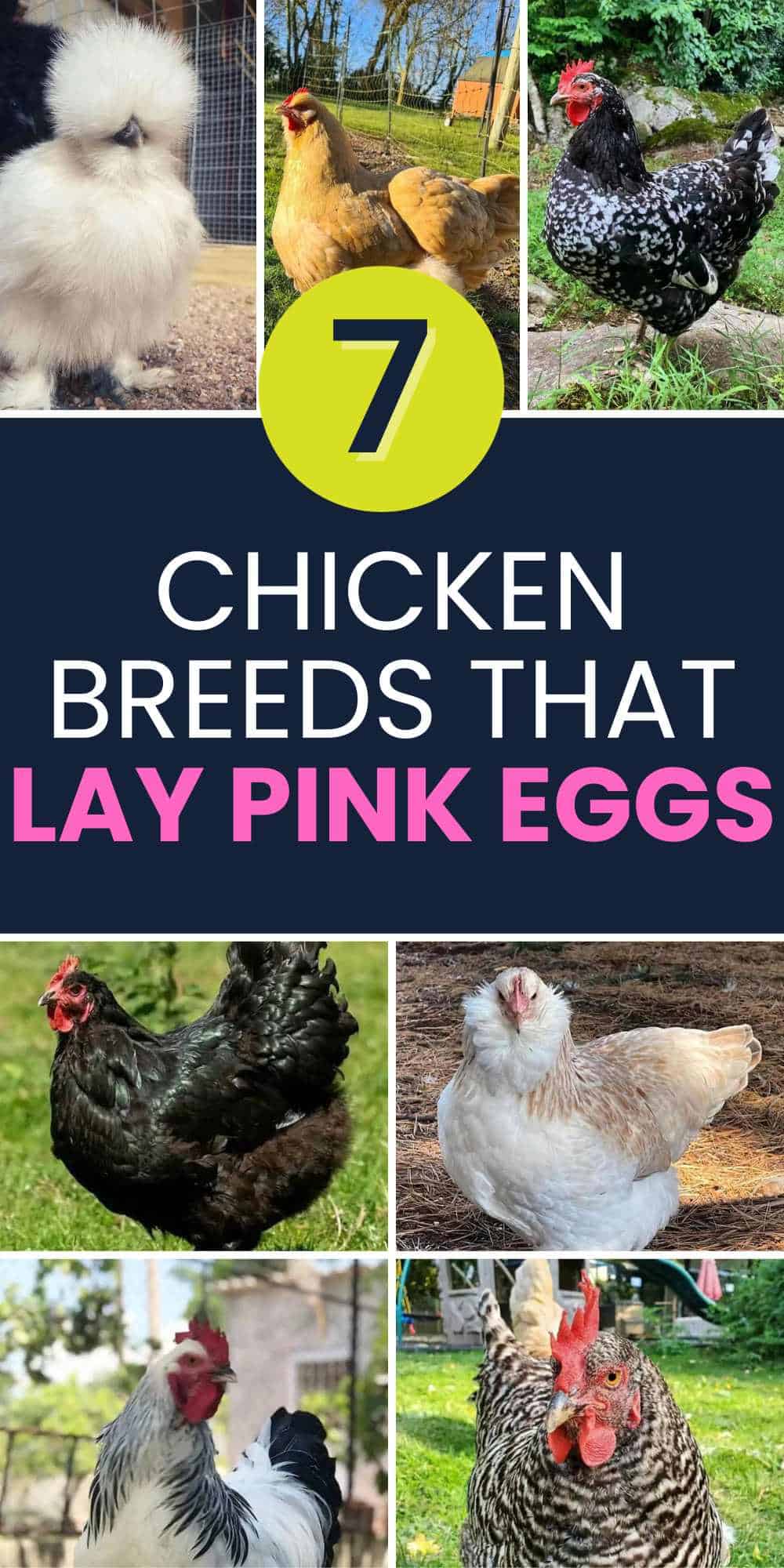

Joseph Hudson has been raising chickens for over 15 years. In 2018, he completed the Agriculture & Natural Resources program at Mt. San Antonio College. He currently raises over 1400 chickens on his 7.5-hectare farm. He keeps sharing his experience on raising healthy and happy chickens on Chicken Scratch The Foundry.
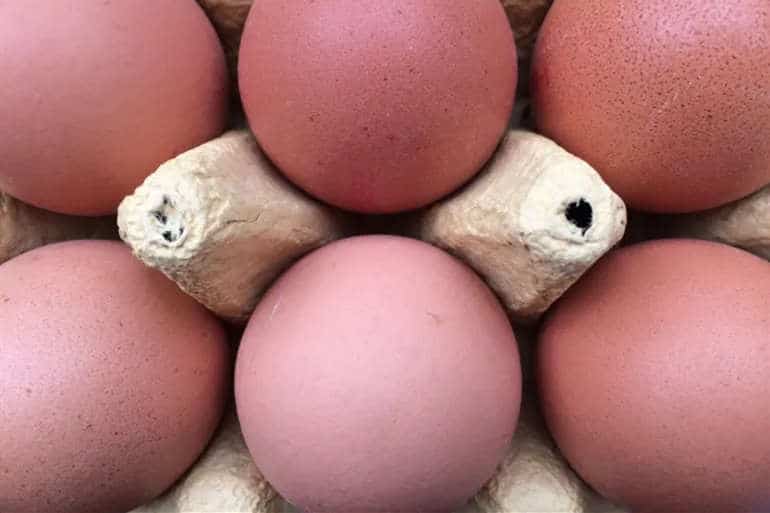








I would like to know more Imformacion how I can buy this can chickening I live in New York State
information on how to purchase these kind of chichens
Wildly inaccurate. Chickens lay eggs much sooner than 18 months as stated here
It’s 18 WEEKS ( actually 16-24 weeks in my experience).